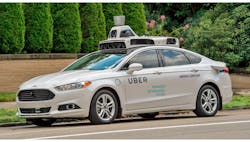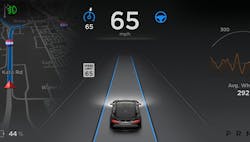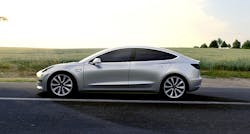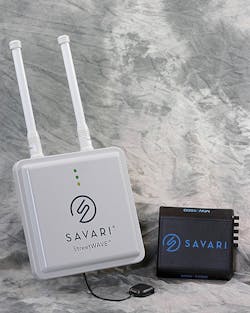This file type includes high-resolution graphics and schematics when applicable.
As autonomous vehicles near closer to reality, the technology continues to be hampered by myths and misconceptions. The truth is, the disruptive force of autonomous vehicles is greater than most people imagine. Just like the “horseless carriage” revolutionized the way people got around a century ago, autonomous vehicles will fundamentally change the way we use and think about cars in the coming years.
Autonomous cars promise to make driving and getting around safer, efficient, and convenient. Nonetheless, let’s look at some of the main “myths” surrounding self-driven cars.
1. We will own our autonomous cars.
There's a reason ride-sharing company Uber is investing heavily in autonomous driving (Fig. 1); with autonomous cars, shared ownership models will make much more sense. Today, many of us who own cars use them just a fraction of the time. Our cars are useless without someone behind the wheel, and for every minute we drive it, the car spends much more time parked on the street or in a garage gathering dust.
Since autonomous vehicles promise to drive themselves, after each trip, instead of sitting idle, they can go immediately to where they are needed next. Besides making private garages obsolete, this will make shared ownership models much more attractive.
Subscription-based models will become popular, as cars transition from being products to services. Residents of a neighborhood, town, or city will own a pool of cars that residents can use as they need, as long as they pay their membership fee.
Even private ownership will look different, as owners may decide to share their car when it’s not in use. Companies like Zipcar and Getaround are already capitalizing on this personal transportation model of the future.
Elon Musk, Tesla Motors' chairman, has proposed the idea of a Tesla Network, where owners of autonomous cars make money leasing their cars to a shared fleet when they’re not using them, similar to the way homeowners with solar power generators currently sell excess power back to the grid.
2. Our cities will be the same, just with more autonomous cars.
While most of us envision a future where the cities we live in today simply have more autonomously driven cars, the nature of autonomous driving will also change fundamental aspects of how our cities are designed.
Take, for example, parking. Today's cities and towns are built with the idea that every location needs a space nearby for cars to be parked. With autonomous cars, vehicles can either drop off their passenger and park itself in a more distant, cheaper garage or directly move on to picking up other passengers. This will significantly reduce the need for parking garages, especially in high-population urban areas.
With less need for parking space, cities can be designed for more pedestrian traffic, and precious urban real estate can be reallocated to parks and promenades, housing, or other higher-value uses.
3. Autonomous cars will look like today's cars.
In the near term, as cars gain Level 2 or 3 automation (according to SAE J3016 levels of automation) and legislation still requires human drivers to take the wheel as a backup, autonomous car designs will not differ much from today's cars. However, in the long term, as cars can fully drive themselves without the need for human guidance, models will change radically.
Current exterior and interior design are centered around keeping a forward-facing driver safe, aware, and in control. But as autonomous technology takes over, interior and exterior design can shift to focus more on passenger comfort and luxury. In the interest of maximizing interior space, steering wheels, pedals, and transmission controls will be retractable or removed entirely, car designs may become more rounded, or box-like, and rear-facing seats may be incorporated. =
4. Tesla's Autopilot is fully autonomous
Since October 2014, Tesla Model S cars and the newer Model X have had an Autopilot feature that lets the car take over driving in controlled highway conditions (Fig. 2). While the car does drive itself when Autopilot is engaged, the driver is still needed to take the wheel in case something unexpected comes up.
A widely publicized accident has reinforced this fact: In May of 2016, a driver using Tesla's Autopilot collided fatally with a tractor trailer (see “Tesla Driver Involved in Fatal Crash with Autopilot Engaged”). The autopilot software did not detect the white tractor trailer against a background of a bright sky.
A portable DVD player found in the wreckage indicated the driver might have assumed too much of the car's self-driving capabilities and was watching a movie when his eyes instead should have been on the road.
5. It will take many years for autonomous cars to become reality.
While autonomous driving is a tremendous technical challenge, the pace of the technology has far outpaced everyone's expectations. Fully autonomous cars and buses are being trialed in cities around the world, and consumer vehicles capable of fully autonomous driving may be on the road as early as 2018.
While Tesla's current Autopilot is Level 2 (requires constant human monitoring) on SAE's levels of autonomy, it has ambitiously planned late 2017 as the deployment goal for its Level 5 fully autonomous driving software update, coinciding with the release of the company’s Model 3 (Fig. 3).
According to Tesla, all current Tesla cars manufactured since October 2016—including the Model 3—have upgraded hardware to perform fully autonomous driving and will be eligible for the Level 5 update when it comes out. The upgrades include additional cameras, ultrasonic sensors, a more powerful computer, and a forward-facing radar, which would have prevented the accident discussed above.
If Tesla meets its goal, there will be thousands of cars capable of fully autonomous driving on the road as soon as 2018.
6. The consumer car market will be the first to be impacted by driverless cars.
With all the news about Tesla's Model S, Model 3, and upcoming autonomous cars from the big consumer car brands, it is easy to think that consumer cars will be the first affected by autonomous driving. However, chances are that commercial vehicles and not consumer cars are almost certainly going to be the first to be strongly impacted by autonomous driving.
While consumer cars have to drive through a variety of road conditions and content with an incredible range of human factors, commercial vehicles often work in more constrained environments, to which autonomous driving systems can adapt to more easily. Trucks, for example, spend most of their drives on highways, a relatively controlled environment and easy for autonomous driving systems to adjust to.
Economically, the case is also strong for commercial vehicles to automate first. Businesses have a strong incentive to buy cars that can work longer, drive better, and cost less to run than one with a human driver.
Legally, even if Tesla achieves its ambitious goal of achieving Level 5 fully autonomous driving by late 2017, a human driver will almost certainly still be required behind the wheel, making it hard to realize the full benefits of self-driving for consumer vehicles. Private environments like college campuses, airports, or industrial settings, on the other hand, benefit from not having to wait for government regulations to catch up with the state of technology.
All of this means that commercial applications like trucking, warehousing, construction sites, university campuses, airports, and public transport will be the first to reap the benefit of autonomous vehicles.
7. The biggest challenge for autonomous driving is adapting to various road conditions.
Fog, poorly painted road markings, missing or damaged signs or traffic lights—these are challenges that flummoxed early autonomous vehicles, but are surely and swiftly being overcome with the newest generation of autonomous driving technology.
Camera and sensor data from millions of miles of road traveled, along with deep learning, are helping companies like Tesla, Google, and Comma Inc. continually improve their self-driving software to deal with poor road conditions, marking, and signage. Along with advancing sensor technology and the ever-expanding variety of sensors featured on future autonomous cars, challenging road conditions are increasingly becoming a solved problem.
Key issues remaining in autonomous driving's future are situations where autonomous vehicles and human drivers must interact in complex scenarios. Legislative, legal, and ethical matters, such as whether autonomous vehicles can operate without a driver or who is at fault when an accident occurs involving an autonomous vehicle, are all serious hurdles that need to be overcome.
8. Solving ethical dilemmas is critical to autonomous driving technology.
While ethical dilemmas are making for great philosophical debates, the place they will have in the world of autonomous driving will be much less than most of us would imagine.
A popular ethical scenario involves an autonomous car that’s about to hit some pedestrians, and it must make a split-second decision: Collide into the pedestrians and save the driver's life, or crash into a wall or guardrail on the side of the road, killing the driver but saving the pedestrians.
In reality, these scenarios are less crucial than those who consider them would think. These types of situations are, first of all, rare even in today's society of human-driven cars. For autonomous vehicles, these situations will be even more limited, as they will be able to react much faster and make better decisions in conditions that would be stressful for human drivers. In the example scenario, for instance, the car would probably have noticed the pedestrians from further away than a human driver, reacted immediately to hit the brakes, and stopped before hitting anyone.
The most difficult decision-making challenges for autonomous driving is far more likely to be situations where some element of risk is involved, or where human interaction is necessary.
Working out who has the right of way at a four-way stop can be a mere matter of human drivers communicating using eye contact or hand gestures, but difficult for self-driving cars. Aggressive maneuvers with a degree of risk—such as making a left turn into a stream of oncoming traffic—are also difficult, but not impossible, scenarios for autonomous cars to navigate.
9. Autonomous cars will have to make all decisions independently.
Today, those of us who drive cars have to drive with the information from our eyes, ears, and other senses, so it’s natural to assume self-driving cars will also have only the information available from its sensors, and navigational system, to work with. In fact, autonomous vehicles may not have to work on their own. Thanks to V2X technology, they may have access to data from other cars and even infrastructure such as traffic signals, or even road signs, to work with.
Vehicle-to-vehicle (V2V) and vehicle-to-infrastructure (V2I) communications blend into vehicle-to-everything (V2X), which is a wireless communication technology that allows cars to communicate with the world around it (Fig. 4). In development for years, the technology has already been standardized across the world. In the U.S., it is known as DSRC-WAVE, and in Europe, it is part of the ITS-G5 standard.
A long time coming, V2X is finally making it to production, integrated into the 2017 Cadillac CTS. If popularized, the ability for cars to communicate wirelessly with other vehicles, stop signs, and people outside the car will go a long way toward helping autonomous vehicles deal with scenarios such as four-way stops, blind intersections, unexpected construction or road hazards, and much more.
10. Autonomous cars will not be safe enough.
With any new technology, fear of the unknown often overrules statistics and reason. Autonomous driving technology is no different. The media has been quick to report on accidents involving self-driving cars, whether it’s Google's self-driving car getting rear-ended at a stop sign, or a Tesla in auto-pilot mode crashing into a tractor trailer. The truth is, all evidence, including the accidents themselves, points to autonomous driving cars being vastly safer to operate than cars driven by humans.
Since 2009, Google's self-driving cars have been in 16 crashes in over 2 million miles. However, in every single case, the human was at fault. Even an accident in August 2016, initially reported as being the fault of the Google Car, was later found to be the fault of human drivers. In this case, a Google car stopped for a pedestrian at a crosswalk, and the car behind it, driven by a human of course, didn't stop quickly enough and crashed into the Google car.
But there's more to the story. The human driving assistant inside the self-driven car may also have been to blame. He felt the car was braking too slowly and fully applied the brakes, manually stopping it quicker than it would have. Left to its own devices, the Google Car may not have gotten into a crash at all.
11. Autonomous driving technology has to be 100% perfect before being deployed.
Autonomous driving technology is not, and will never be perfect. Neither are human drivers, though, and yet every day millions of us get on the road. For autonomous driving to succeed, it doesn’t need to prevent all accidents or perform correctly in 100% of all driving situations; it simply needs to be better than us.
According to the National Safety Council (NSC), on average, 100 people were killed in America each day due to automobile accidents. The 2015 National Motor Vehicle Crash Causation Survey (NMVCCS), conducted from 2005 to 2007, concluded that the critical reasons for 94% of crash events were due to the driver. In about 2% (±0.7%) of the crashes, the critical reason was assigned to a vehicle component’s failure or degradation; and in another 2% (±1.3%) of crashes, it was attributed to the environment (e.g., slick roads, weather). Elon Musk argues that since autonomous driving technology can reduce these statistics by a significant margin—and save lives—it should be deployed as soon as possible.
The numbers seem to back up his claims. Though Tesla's cars have racked up a fatality due to a machine-vision error, statistically, the single fatality in the over 200 million miles driven by Tesla cars on Autopilot far outweighs the national average of one death per 90 million miles driven. With upgraded sensors and software now standard on newer Tesla models, all signs point to their safety figures only improving over time.
With no blind spots, much faster reaction times, and software that's always getting better, today's Level 2 semi-autonomous vehicles are already driving much safer than we can. When Level 5 vehicles, with improved sensors and software, do come around, there will be no contest.







